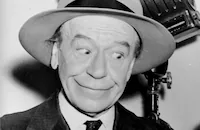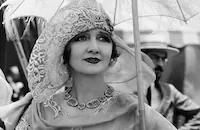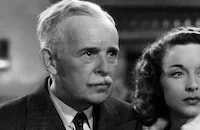Artists and Models
Brief Synopsis
Cast & Crew
Raoul Walsh
Jack Benny
Ida Lupino
Richard Arlen
Gail Patrick
Ben Blue
Film Details
Technical Specs

Synopsis
Mac Brewster of Brewster Advertising Agency has been named chairman of the Artists and Models Ball and must choose a queen for the event. In exchange for a million dollar ad campaign, Mac promises Alan Townsend of Townsend Silver that he will make the yet-to-be-found "Townsend Silver Girl" queen of the ball. Mac then promises his girl friend, Paula Sewell, a working class model, that she will be the queen. Alan, however, wants to use a girl who has stepped out of the social register, not an actress. Consequently, when Cynthia Wentworth of Park Avenue visits him at his office selling tickets to a charity, he offers her the Townsend Girl title. Mac, meanwhile, proposes to Paula, and they become engaged. Deciding she has the "clothes and the nerve" to pose for Alan, Paula goes to Miami under the name Paula Monterey and hob-nobs with the rich. Paula charms Alan, and after they dance, they end up taking a midnight dip in the pool together, at which point Alan calls Paula "Cinderella." Meanwhile, Mac meets Cynthia and assumes she is a model. When she reveals that she is one of the Park Avenue Wentworths, he names her the Townsend Girl. In Miami, Paula upholds her façade as a society girl, and Alan names her the Townsend Girl. The two couples then reunite in Miami, and Mac learns that Alan has already promised the job to Paula, with whom he has fallen in love. Later, Paula breaks her engagement with Mac, admitting her love for Alan. Alan's mother then discovers Paula is a professional model, causing Alan to think Paula has used him; but he allows her to remain the Townsend Girl. Two months later, on the night of the ball, both Cynthia and Paula propose to Mac, planning to announce his answer at the ball. At the ball, Paula's roommate, Toots, tells Alan that Paula is in love with him, and Paula and Cynthia each choose the man they will announce that evening. At the stroke of midnight, Paula, as the queen, loses her shoe, and Alan appears in costume to replace it, telling her she is the Townsend Girl. Both happy couples then march off stage.

Director

Raoul Walsh
Cast

Jack Benny

Ida Lupino

Richard Arlen

Gail Patrick

Ben Blue

Judy Canova
The Yacht Club Boys

Cecil Cunningham

Donald Meek

Hedda Hopper

Martha Raye
Andre Kostelanetz And His Orchestra
Louis Armstrong And His Orchestra

Judy Canova
Anne Canova
Zeke Canova
Connie Boswell
Peter Arno
Mcclelland Barclay
Arthur William Brown
Rube Goldberg
John Lagatta
Russell Patterson
Sandra Storme
Kathryn Kay
Mary Shepherd
Gloria Wheeden
Madelon Grey
Alan Birmingham
Dell Henderson
Harry Hayden
Antrim Short
Virginia Brissac
Henry C. Johnson
Harry C. Johnson
Jack Starry
Harvey Poirier
Pat Moran
Jack Mcafee
Irene Mcafee
Elsa Connor
Nick Lukats
Jack Daley
David Newell
Carl Harbaugh
Little Billy
Dale Armstrong
Arthur Shank
Edward Earle
John Spacey
Alexander Pollard
Alphonse Martel
Jane Weir

Howard Hickman
Reginald Simpson
Jerry Jerome
Bernie Lamont
Bert Lebaron
Rex Moore
David Robel
Paramount Gypsy Dancers
Artists And Models Sextettle
Ethel Clayton
Gloria Williams
John Marshall
Crew
Harold Arlen
Travis Banton
Edmund Beloin
Phil Boutelje
John Burch
Russel Crouse
Walter Deleon
Hans Dreier
A. E. Freudeman
Lewis E. Gensler
Eve Greene
Sig Herzig
Frederick Hollander
Gordon Jennings
Ted Koehler
Burton Lane
William Le Baron
Harold Lewis
Howard Lindsay
Alma Ruth Macrorie
Francis Martin
Louis Mesenkop
Victor Milner
Vincente Minnelli
Boris Morros
William Morrow
Leroy Prinz
Leo Robin
Gene Thackrey
The Yacht Club Boys
Robert Usher
Harlan Ware
Victor Young
Adolph Zukor

Photo Collections
Videos
Movie Clip






Film Details
Technical Specs

Award Nominations
Best Song
Articles
Artists & Models (1937)
This was Ida Lupino's last movie for Paramount under her contract with the studio. She'd been growing wary of being placed in forgettable pictures and felt that the studio was wasting her abilities. Eventually she obtained a new agent and a two-picture deal at Columbia, and within a few years she was at Warner Brothers making classics such as They Drive by Night (1940) and High Sierra (1941). A decade later, she'd begin a significant directing career.
Artists & Models is notable also as the first film to include work by Vincente Minnelli. He was brought to the studio from New York, where he'd been working in the theater, to design the musical number "Public Melody No. 1." According to author Stephen Harvey, Minnelli came up with "the concept" for the number but did not fully choreograph or direct it. In fact, Minnelli "felt the result was a chaotic travesty of his original notion." As time went on, it became clear that Paramount was intimidated by Minnelli's artistic ambitions. Minnelli grew frustrated, bought out his contract, and returned to New York. Later, of course, he tried Hollywood again and ended up as one of the greatest directors (of musicals and other genre films) in history.
"Public Melody No. 1" caused a ruckus in some states due to its onscreen blending of white and black performers. Martha Raye was particularly lambasted by racist southern theater owners and newspaper publishers for dancing on-screen with "negroes." Even Variety chimed in on this, saying in its review, "This intermingling of the races isn't wise, especially as [Raye] lets herself go into the extremest manifestations of Harlemania torso-twisting and gyrations." On the other hand, Variety said of the movie as a whole that it "holds enough variety, comedy, color, spec, flash, dash and novelty for a couple of pictures."
The New York Times agreed, calling the picture "a suave, witty and polished show, one of the sprightliest of the season's musical comedies... Mr. Benny, still the drollest comic on the screen, doesn't miss a bet and turns in his best performance to date."
Artists & Models drew an Oscar® nomination for Best Song, for "Whispers in the Dark" by Friederich Hollaender and Leo Robin. It lost to "Sweet Leilani" from Waikiki Wedding (1937). The film was successful enough for Paramount to produce a follow-up called Artists and Models Abroad (1938). It again starred Benny but was a sequel in title only and did not do as well at the box office.
Look for famed cartoonist Rube Goldberg in his only movie appearance -- yes, the Rube Goldberg, the man whose name became a still-used term for outrageously complicated contraptions that perform simple tasks or nothing at all. Goldberg would win a Pulitzer Prize in 1948 for editorial cartooning. He is billed in the picture with several other names as one of "America's leading artists and illustrators," and he plays an artist as part of the number "Mr. Esquire" -- an imaginative set-piece involving puppets made to resemble famous Paramount stars of the day such as Burns and Allen, W.C. Fields, Carole Lombard and Claudette Colbert.
Also keep an eye out for Hollywood gossip columnist and occasional actress Hedda Hopper, in the role of Mrs. Townsend.
Producer: Lewis E. Gensler
Director: Raoul Walsh
Screenplay: Walter DeLeon, Lewis E. Gensler, Francis Martin; Eve Greene, Harlan Ware (adaptation); Sig Herzig, Eugene Thackrey (story)
Cinematography: Victor Milner
Music: Robert Russell Bennett, Gordon Jenkins, John Leipold, Leo Shuken (all uncredited)
Film Editing: Ellsworth Hoagland
Cast: Jack Benny (Mac Brewster), Ida Lupino (Paula Sewell aka Paula Monterey), Richard Arlen (Alan Townsend), Gail Patrick (Cynthia Wentworth), Ben Blue (Jupiter Pluvius), Judy Canova (Toots), Charles Adler (Yacht Club Boys), James V. Kern (Yacht Club Boys), George Kelly (Yacht Club Boys), Billy Mann (Yacht Club Boys), Cecil Cunningham (Stella), Donald Meek (Dr. Zimmer), Hedda Hopper (Mrs. Townsend).
BW-97m.
by Jeremy Arnold
Sources:
William Donati, Ida Lupino
Stephen Harvey, Directed by Vincente Minnelli
Raoul Walsh, Each Man in His Time

Artists & Models (1937)
Quotes
Trivia
Notes
The title of Sig Herzig and Gene Thackrey's original story was "Venus in Velvet." Artists and Models was the name of a series of revues produced in New York by Lee and Jacob J. Shubert from 1923-1930 that featured nude models in frozen poses and scores of chorus girls performing lavish dance numbers. As reported in Hollywood Reporter on January 24, 1936, Paramount purchased the rights to the title "Artists and Models" from the Shuberts. According to a modern source, the Shubert revues were devised as competition to the "scantily clad lovelies" of the Earl Carroll Vanities. The sequel to this film is called Artists and Models Abroad (see below). Eastern Service Studios, formerly known as Astoria Studios, were originally owned by Paramount. In March 1932, Paramount suspended all feature production at Astoria and sold the lot to Eastern Service Studios, Inc. A handful of Paramount films were made at Astoria after March 1932, including a series of Ben Hecht-Charles MacArthur films in 1934 (see entry for Crime Without Passion below). According to a news item in Hollywood Reporter on March 2, 1937, A. Edward Sutherland turned down the directorial assignment for this film in order to take a vacation. Copyright records credit Ellsworth Hoagland as editor, although he is not listed on the film. Billed in onscreen credits as "America's leading artists and illustrators," Arno, Barclay, William, Goldberg, LaGatta and Patterson, actually painted pictures of models for the stageshow scene within this film. Sandra Storme is billed as "England's most famous model." Film Daily credits "59 models" as appearing in the film. Russell Patterson's "Personettes," marionettes, appear in a number called "Mr. Esquire" in the Miami hotel floorshow scene. The floorshow "orchestra" consisted entirely of these puppets. According to the pressbook, the puppets were made to resemble George Burns and Gracie Allen, W. C. Fields, Bob Burns, Carole Lombard, Claudette Colbert, Martha Raye, George Raft, Edward Everett Horton, and the Yacht Club Boys. The pressbook includes the "Cycling Starys" among the film's specialties, although only Jack Stary is credited in the pressbook cast list and in the Call Bureau Cast Service. The pressbook also credits a tumbler named Fawcett in addition to Pat Moran. In addition to Judy Canova's single billing, the Canova family is billed as "Judy, Anne and Zeke." The Yacht Club Boys are: Charlie Adler, Jimmy Kern, George Kelly, and Billy Mann.
During the Artists and Models Ball scene, Martha Raye sings "Public Melody No. 1" with Louis Armstrong and his orchestra in a mock Harlem gangster setting. The film's pressbook called the scene "the largest, and hottest, Negro number ever filmed in Hollywood." In response to the scene, Variety remarked: "This intermingling of the races isn't wise, especially as [Raye] lets herself go into the extremest manifestations of Harlemania torso-twisting and gyrations. It May hurt her personally." According to files in the MPAA/PCA Collection at the AMPAS Library, local censors were outraged at Raye's interaction with blacks on the screen. On August 25, 1937, Dolph Frantz, Managing Editor of the Shreveport Journal, wrote to Adolph Zukor, head of Paramount, the following: "Without wishing to appear in the role of an unkind or unfriendly critic, I will appreciate you granting me the privilege of expressing my protest against the social equality tone in the picture Artists and Models, which I understand was produced under your direction. I was dreadfully disappointed and displeased at the mixture of negroes with white persons in the specialty by Martha Raye that I could not get much enjoyment from it....For negroes and whites to be shown in social equality roles is offensive in this part of the country, where the races have nothing socially in common. It never fails to offend the white citizens of this section, and I have an idea that many negroes have the same feeling because my lifetime observation has been that representative negroes in the Southland wish none of the social equality ideas. Please do not get the impression that I am antagonistic to negroes. Rather, I am their friend. I feel certain representative negro citizens here will say that I am a genuine friend of the negroes, but, of course, they must stay in their place and not try any social equality plans. Our Newspaper, which has the same policy as most others throughout the South, will not publish negroes as Mr. and Mrs., nor will it publish negroes' pictures, but unfailingly it publishes worthwhile things they do. I hope you will understand my position in writing on this subject. I confidently believe that if the practice of mixing the races in pictures continues much longer, the reaction will be very hurtful to the picture industry in this part of the country."
On August 31, 1937, Mrs. Alonzo Richardson, the chairperson of the Atlanta Board of Review wrote to Joseph I. Breen, director of the PCA, the following: "I have one large squawk, for there is always one, you know, in Artists and Models. I am conferring with the manager and I believe we will cut Martha Raye's cabaret scene out entirely. This would be a matter of friendly consideration for Miss Raye as well as expedient for the theatre. For a white woman to act with negroes is a most certain offense to the south. For ANYONE to act in as obscene a manner as Miss Raye does, in this scene, would offend good taste anywhere, but, in the south, and with negroes, it will certainly be her finish. A very disgusted previewer remarked, 'She out-niggers the niggers.' Her postures, her dancing, her whole presentation of this scene is altogether disgusting and so it was agreed at the preview. In the south, white women can't act with negroes themselves on the same plane. There is a place for both in the pictures, and each in his proper place makes for real art; but such as Miss Raye's performance is nothing but disgusting. I am simply telling you the reaction to the picture as we previewed it and I believe the kind and wise thing will be to cut this scene out altogether. Maybe we are provincial, but a lady must be a lady and no one has a keener contempt for a white woman who descends to their level than the negro himself. One wiggle of Miss Raye's stomach condemned her."

Miscellaneous Notes
Released in United States 1937
Released in United States 1937













